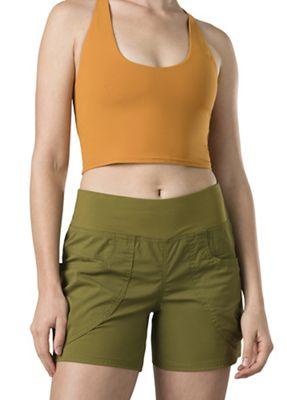Climbing is not only a fun and adventurous activity, but also a great way to build muscle and strength.
Climbing engages your whole body, from your fingers to your toes, and challenges you to overcome gravity and balance.
In this blog post, we will explain how climbing can help you develop different muscle groups, improve your endurance and power, and boost your confidence and mental health.
We will also show you some of the best women’s climbing shorts that can make your climbing experience more comfortable and enjoyable. Ready to rock?
What Muscles are Commonly Used in Rock Climbing?
Rock climbing uses almost every muscle in your body, but some are more dominant than others. Here are some of the main muscles that are involved in rock climbing:
Forearms
Your forearms are responsible for gripping the holds and controlling your hand movements.
They are composed of many small muscles that work together to flex and extend your fingers and wrists.
Your forearms are one of the first muscles to fatigue when climbing, so it is important to train them for endurance and strength.
Biceps
Your biceps are responsible for bending your elbows and pulling yourself up. They are composed of two heads that attach to your shoulder and forearm bones.
Your biceps are often used in conjunction with your back muscles when climbing overhangs or roofs.
Triceps
Your triceps are responsible for straightening your elbows and pushing yourself away from the wall.
They are composed of three heads that attach to your shoulder blade and forearm bones.
Your triceps are often used in conjunction with your chest muscles when climbing slabs or vertical walls.
Shoulders
Your shoulders are responsible for stabilizing your arms and rotating them in different directions.
They are composed of several muscles that attach to your collarbone, shoulder blade, upper arm bone, and ribs.
Your shoulders are often used in conjunction with your core muscles when climbing dynamically or reaching for distant holds.
Back
Your back is responsible for supporting your spine and pulling your shoulder blades together.
It is composed of several layers of muscles that attach to your spine, ribs, pelvis, shoulder blades, and upper arm bones.
Your back is often used in conjunction with your biceps when climbing overhangs or roofs.

Core
Your core is responsible for stabilizing your spine and transferring force between your upper and lower body.
It is composed of several muscles that attach to your spine, ribs, pelvis, hips, and legs.
Your core is often used in conjunction with your shoulders when climbing dynamically or reaching for distant holds.
Glutes
Your glutes are responsible for extending your hips and rotating your legs outward. They are composed of three large muscles that attach to your pelvis, femur, and sacrum.
Your glutes are often used in conjunction with your hamstrings when climbing steep walls or mantling over ledges.
Hamstrings
Your hamstrings are responsible for bending your knees and extending your hips.
They are composed of three long muscles that attach to your pelvis, femur, and lower leg bones.
Your hamstrings are often used in conjunction with your glutes when climbing steep walls or mantling over ledges.
Quadriceps
Your quadriceps are responsible for straightening your knees and flexing your hips.
They are composed of four large muscles that attach to your pelvis, femur, and lower leg bones.
Your quadriceps are often used in conjunction with your calves when climbing slabs or vertical walls.
Calves
Your calves are responsible for pointing your toes and lifting your heels. They are composed of two large muscles that attach to your lower leg bones and heel bone.
Your calves are often used in conjunction with your quadriceps when climbing slabs or vertical walls.
What Defines a Rock Climber Body?
A rock climber body is defined by its functionality, not by its appearance. A rock climber body is lean, toned, and strong, but not bulky or muscular.
A rock climber body is adaptable, flexible, and agile, but not rigid or stiff.
A rock climber body is balanced, symmetrical, and proportional, but not asymmetrical or disproportionate.
A rock climber body is the result of climbing regularly and consistently, as well as following a healthy diet and lifestyle.
A rock climber body is not the result of following a specific workout routine or diet plan, although these can help supplement your climbing.
A rock climber body is not the result of taking supplements or steroids, although these can have negative effects on your climbing.
Is Climbing a Good Workout for Getting Ripped?
Climbing is a good workout for getting ripped, but not in the same way as weight training or bodybuilding.
Climbing will help you burn calories, lose fat, and tone your muscles, but it will not make you gain a lot of muscle mass or size.
Climbing will help you get fit, strong, and healthy, but it will not make you look like a fitness model or a bodybuilder.
If you want to get ripped from climbing, you need to focus on the quality and intensity of your climbing sessions, rather than the quantity and duration.
You need to climb hard routes that challenge your strength, power, and endurance, rather than easy routes that only work your endurance.
You need to climb dynamically and explosively, rather than statically and slowly. You need to climb with good technique and efficiency, rather than with brute force and waste.
You also need to complement your climbing with other exercises that target the muscles that climbing does not work as much, such as your chest, legs, and core.
You can do exercises such as push-ups, squats, planks, and lunges at home or at the gym.
You can also do exercises that improve your flexibility and mobility, such as yoga, stretching, and foam rolling.


